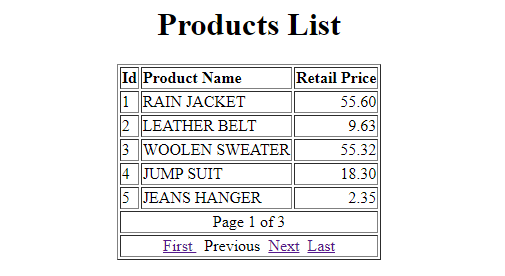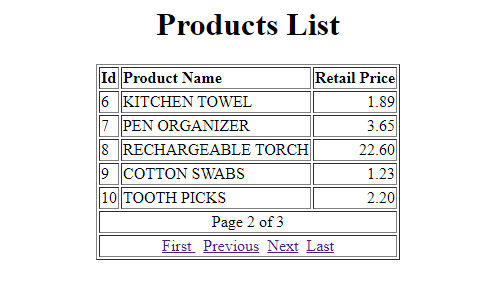
Introduction
Paging is a method of retrieving small, defined chunks from a larger set of data. For example, if you're running an online store with thousands of products, you can display 50 items at a time and give customers navigation buttons to move between the pages.
In PostgreSQL, you can retrieve pages with the LIMIT and OFFSET clauses. Use the LIMIT clause to define the number of rows to retrieve and the OFFSET keyword to specify the number of rows to skip from the beginning.
Prerequisite
To complete this PostgreSQL pagination tutorial, ensure you have the following.
- An Ubuntu 20.04 server.
- A non-root user with
sudorights. - A PostgreSQL database server.
- Apache webserver and PHP. For this tutorial, you can skip Step - 2. Install a Database Server since you'll use PostgreSQL as the database server.
1. Install PHP Extensions
SSH to your server and update the package information index.
$ sudo apt -y updateInstall the
pdo_pgsqldriver. PHP requires this extension to communicate to the PostgreSQL server.$ sudo apt install -y php-pgsqlRestart Apache to load the new changes.
$ sudo systemctl restart apache2
2. Create a Test Database
Log in to your PostgreSQL server as the
postgresuser.$ sudo -u postgres psqlEnter the password and press Enter to proceed.
Create a
test_shopdatabase.postgres=# CREATE DATABASE test_shop;Switch to the new
test_shopdatabase.postgres=# \c test_shop;Create a
productstable.test_shop=# CREATE TABLE products ( product_id SERIAL PRIMARY KEY, product_name VARCHAR (50), retail_price NUMERIC );Insert some data into the
productstable.test_shop=# INSERT INTO products(product_name, retail_price) VALUES ('RAIN JACKET', 55.60 ); INSERT INTO products(product_name, retail_price) VALUES ('LEATHER BELT', 9.63); INSERT INTO products(product_name, retail_price) VALUES ('WOOLEN SWEATER', 55.32); INSERT INTO products(product_name, retail_price) VALUES ('JUMP SUIT', 18.30 ); INSERT INTO products(product_name, retail_price) VALUES ('JEANS HANGER', 2.35); INSERT INTO products(product_name, retail_price) VALUES ('KITCHEN TOWEL', 1.89); INSERT INTO products(product_name, retail_price) VALUES ('PEN ORGANIZER', 3.65); INSERT INTO products(product_name, retail_price) VALUES ('RECHARGEABLE TORCH', 22.60); INSERT INTO products(product_name, retail_price) VALUES ('COTTON SWABS', 1.23); INSERT INTO products(product_name, retail_price) VALUES ('TOOTH PICKS', 2.20); INSERT INTO products(product_name, retail_price) VALUES ('USB CABLE', 3.50); INSERT INTO products(product_name, retail_price) VALUES ('QUICK CHARGER', 35.60);Make sure the records are in place by executing a
SELECTstatement against theproductstable.test_shop=# SELECT product_id, product_name, retail_price FROM products;Confirm the output below.
product_id | product_name | retail_price ------------+--------------------+-------------- 1 | RAIN JACKET | 55.60 2 | LEATHER BELT | 9.63 3 | WOOLEN SWEATER | 55.32 4 | JUMP SUIT | 18.30 5 | JEANS HANGER | 2.35 6 | KITCHEN TOWEL | 1.89 7 | PEN ORGANIZER | 3.65 8 | RECHARGEABLE TORCH | 22.60 9 | COTTON SWABS | 1.23 10 | TOOTH PICKS | 2.20 11 | USB CABLE | 3.50 12 | QUICK CHARGER | 35.60 (12 rows)Exit PostgreSQL.
test_shop=# \q
3. Create a PHP Script
To display paged PostgreSQL data, you'll connect to your database from a PHP script. Then, you'll display the data on a standard HTML web page.
Your PHP file should reside in the root directory of your webserver. To create it, open a new
/var/www/html/products.phpfile usingnano.$ sudo nano /var/www/html/products.phpDefine a new HTML document and include a
title, ahead, and abodytag. Then, define an HTMLtable. You'll use it to list the products from your database.<html> <head> <title>Paginated PostgreSQL Data</title> </head> <body> <h1 align = 'center'> Products List </h1> <table align='center' border='1px'> <tr align='left'> <th>Id</th> <th>Product Name</th> <th>Retail Price</th> </tr>Create the PHP content below to connect to the database that you created earlier. Replace
EXAMPLE_PASSWORDwith the correct password for thepostgresuser.<?php try { $db_name = 'test_shop'; $db_user = 'postgres'; $db_password = 'EXAMPLE_PASSWORD'; $db_host = 'localhost'; $pdo = new PDO('pgsql:host=' . $db_host . '; dbname=' . $db_name, $db_user, $db_password); $pdo->setAttribute(PDO::ATTR_ERRMODE, PDO::ERRMODE_EXCEPTION); $pdo->setAttribute(PDO::ATTR_EMULATE_PREPARES,false);Define an
$sql_countstatement below. Use the PDOprepareandexecutemethods to get the total count of products and place the results in a$countvariable.$sql_count = 'select count(*) as count from products '; $stmt = $pdo->prepare($sql_count); $stmt->execute(); $row_count = $stmt->fetch(); $count = $row_count['count'];In this script, you're retrieving the current page using the
pageURL variable. The value changes once you click the navigation links. Use the code below to retrieve the$_GET['page']variable only if set. Otherwise, use1as the default$pagevalue.if (isset($_GET['page'])) { $page = $_GET['page']; } else { $page = 1; }Assign the variable
$per_pagea value; this controls the total products that you want to display on each page. For this tutorial, use5. When you visit this script on a web browser, you'll see5products on each page. To instruct the PHP script the total number of pages that it should expect, use the formula$total_pages = ceil($count / $per_page);. This rounds off any decimals since it is not possible to have fractions in pages.In this guide, your page count(
$total_pages) should be3since yourproductstable has12records. If you divide12by5, you'll get2.4. After rounding this figure off with the PHPceilfunction, you get3pages.Next, define an
$offsetvariable. This represents the number of rows to skip when executing the$sqlstatement. Determine the value of this variable using the formula($page - 1) * $per_page;. To page the results fromproductstable, include the$per_pageand$offsetvariables in the SQL string using the syntax...limit ' . $per_page . ' offset ' . $offset.$per_page = 5; $offset = ($page - 1) * $per_page; $total_pages = ceil($count / $per_page); $sql = 'select product_id, product_name, retail_price from products limit ' . $per_page . ' offset ' . $offset ;Prepare the SQL command above and execute it. When the
sqlstring is completed, it should execute the following commands depending on the currentpage.Page 1: /products.php?page=1
'select product_id, product_name, retail_price from products limit 5 offset 0;
Page 2: /products.php?page=2
'select product_id, product_name, retail_price from products limit 5 offset 5;
Page 3: /products.php?page=3
'select product_id, product_name, retail_price from products limit 5 offset 10;
Enter the code below to loop through the records and list them on the HTML table.
$stmt = $pdo->prepare($sql); $stmt->execute(); while ($row = $stmt->fetch(PDO::FETCH_ASSOC)) { echo '<tr> <td>' . $row['product_id'] . '</td> <td>' . $row['product_name'] . '</td> <td align="right">' . $row['retail_price'] . '</td> </tr>'; }Echo out the current page number and the total pages in a new table row.
echo "<tr align='center'>" . "<td colspan='3'>Page " . $page . " of " . $total_pages . "</td>" . "</tr>";Populate the
$pagination_urlsvariable. This is a list of clickable navigation links for moving between the pages. TheFirstpage andLastpage links are mandatory and will be active on all pages.$pagination_urls = ''; $pagination_urls .= "<a href='/products.php?page=1'>First </a>";To display a
Previouspage link, get the value of the current page from the$pagevariable and decrement it once. Use the PHPif (...) {...} else {...}to disable the link by removing thehreftag if you're already on theFirstpage.if ($page != 1) { $pagination_urls .= " <a href='/products.php?page=". ($page - 1) . "'>Previous</a>"; } else { $pagination_urls .= " <a>Previous</a>"; }To get a link for the
Nextpage, increment the$pagevariable once. Also, disable theNextpage link if you're already on theLastpage.if ($page != $total_pages) { $pagination_urls .= " <a href='/products.php?page=". ($page + 1) . "'>Next</a>"; } else { $pagination_urls .= " <a>Next</a>"; } $pagination_urls .= " <a href='/products.php?page=" . $total_pages ."'>Last</a>";Finally, echo out the pagination URLs inside a
<td>tag and close thephp,table,body, andhtmltags.echo "<tr align='center'>" . "<td colspan='3'>" . $pagination_urls . "</td>" . "</tr>"; } catch (PDOException $e) { echo 'Database error.' . $e->getMessage(); } ?> </table> </body> </html>
When completed, your PHP file should be similar to the following content.
<html>
<head>
<title>Paginated PostgreSQL Data</title>
</head>
<body>
<h1 align = 'center'> Products List </h1>
<table align='center' border='1px'>
<tr align='left'>
<th>Id</th>
<th>Product Name</th>
<th>Retail Price</th>
</tr>
<?php
try {
$db_name = 'test_shop';
$db_user = 'postgres';
$db_password = 'EXAMPLE_PASSWORD';
$db_host = 'localhost';
$pdo = new PDO('pgsql:host=' . $db_host . '; dbname=' . $db_name, $db_user, $db_password);
$pdo->setAttribute(PDO::ATTR_ERRMODE, PDO::ERRMODE_EXCEPTION);
$pdo->setAttribute(PDO::ATTR_EMULATE_PREPARES,false);
$sql_count = 'select count(*) as count
from products
';
$stmt = $pdo->prepare($sql_count);
$stmt->execute();
$row_count = $stmt->fetch();
$count = $row_count['count'];
if (isset($_GET['page'])) {
$page = $_GET['page'];
} else {
$page = 1;
}
$per_page = 10;
$offset = ($page - 1) * $per_page;
$total_pages = ceil($count / $per_page);
$sql = 'select
product_id,
product_name,
retail_price
from products
limit ' . $per_page . ' offset ' . $offset ;
$stmt = $pdo->prepare($sql);
$stmt->execute();
while ($row = $stmt->fetch(PDO::FETCH_ASSOC)) {
echo '<tr>
<td>' . $row['product_id'] . '</td>
<td>' . $row['product_name'] . '</td>
<td align="right">' . $row['retail_price'] . '</td>
</tr>';
}
echo "<tr align='center'>"
. "<td colspan='3'>Page " . $page . " of " . $total_pages . "</td>"
. "</tr>";
$pagination_urls = '';
$pagination_urls .= "<a href='/products.php?page=1'>First </a>";
if ($page != 1) {
$pagination_urls .= " <a href='/products.php?page=". ($page - 1) . "'>Previous</a>";
} else {
$pagination_urls .= " <a>Previous</a>";
}
if ($page != $total_pages) {
$pagination_urls .= " <a href='/products.php?page=". ($page + 1) . "'>Next</a>";
} else {
$pagination_urls .= " <a>Next</a>";
}
$pagination_urls .= " <a href='/products.php?page=" . $total_pages ."'>Last</a>";
echo "<tr align='center'>"
. "<td colspan='3'>" . $pagination_urls . "</td>"
. "</tr>";
} catch (PDOException $e) {
echo 'Database error.' . $e->getMessage();
}
?>
</table>
</body>
</html>Save the file by pressing Ctrl + X, then Y and Enter. Your PostgreSQL pagination script is now ready for testing.
4. Test the PHP Script
In a web browser, visit the URL below and replace 192.0.2.1 with your server's correct public IP address or domain name.
http://192.0.2.1/products.php
You should now see the First page displaying 5 products as shown below. As you can see from the output below, the Previous page link is disabled since you're already on the First page.
Page 1:

Click Next to navigate to the second page and note how the URL on your web browser changes to include the
pageparameter.Page 2:

Again, click Next or Last to navigate to the
Lastpage. The Next link is disabled on this page since you're already on theLastpage.Page 3:

The above outputs confirm that your PHP script is now working as expected.
Conclusion
In this guide, you've created a sample database and a table. You've then populated the table with sample records and coded a PHP script to page data using the PostgreSQL LIMIT and OFFSET clauses. Use the syntax in this guide to page your database data when working with many records.
No comments yet.